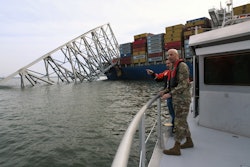
In the fleet world, just as in any business, there are known unknowns. We know they’re there, even if we can’t see them. Think of them as blind spots. And like blind spots, we want better visibility. Blind spots lead to unwanted eventualities, and nobody wants either. What everybody does want is to know what’s in those blind spots so they can eliminate them.
For fleet managers, it’s all too often a case of, “if only”… If only they had visibility of that blind spot, they’d understand what’s behind the bottlenecks and supply chain issues they’re constantly fighting. If only they knew what was causing that blind spot, they’d know what’s in it, and calculate the sum of its effects. If only they knew how to get rid of that blind spot.
Enough with “if only." It’s time to eliminate these blind spots. But to do so means understanding what they are and what causes them.
In the fleet world, blind spots exist for many reasons. They exist between vendors, because each vendor has its own system to manage performance; between business lines that use different reporting metrics; and even between departments, because reporting still relies on human efficiency (and competency!).
For clear visibility, fleets need the ability to access and integrate relevant information from appropriate business lines, which includes vehicle acquisition and upfitting, delivery and customer use, re-leasing or evaluating the vehicle, and then choosing remarketing channels. Ideally, they’d have the ability to consolidate information from all those vendors, and bring it together in a single platform that provides a complete overview of everything that's running in their business.
Accentuate the positive
Clearly, blind spots are a big negative, so let’s flip this: eliminating blind spots is a big positive. With visibility into the previously unknown, fleets can monitor process flows all the way from vehicle acquisition to off-boarding. They’d then be able to compare processes across countries and across business divisions, identify efficiencies, save money, accelerate processes, and potentially increase revenue, growing their business by increasing vehicle yield and boosting client satisfaction. More effective as an organization, a fleet with clear visibility can proactively strengthen performance throughout its value chain.
Everyone benefits from visibility. Think of a typical order from an online delivery company such as, say, Amazon. Notified that your $12 package of AA batteries is on its way, a quick look at your phone shows you the exact location of your order, an accurate delivery window, and maybe even a picture of the package on your doorstep once delivered.
So why, for a $50,000 asset like a new vehicle, can you not pull up an interface that shows where your order is, and when it will be delivered?
This is not about gathering more information – it’s already there, it’s just held in silos, caught up in one of those bottlenecks mentioned earlier. Maybe it’s in a colleague’s unsent email, or an unsaved database entry.
Knowing exact delivery status isn’t just interesting, it’s business critical. With a 360-degree perspective, a fleet manager can compare several vendors, and use that insight to make key decisions and savings calculations: Cut costs by 5%, or deliver to the customer 5% more quickly? Get it right, and everyone’s a winner.
How to find those blind spots
Where once the big consultancies would project manage multi-year, multi-million-dollar software and ERP system rollouts to streamline workflows, optimize businesses and find operational blind spots, contemporary best practice for determining blind spots involves creating process maps. Designed to map a company’s existing process flows, using its current systems and vendors, MIFA (Material and Information Flow Analysis) is a much easier way of revealing bottlenecks.
MIFA’s lightweight integrations to existing stacks enable fleet managers to extract critical information from each system and aggregate it to see statistics across the entire business. This reveals the information needed for operational decision-making, such as areas of the business that need attention, which vendors to swap, and where to tighten linkages between departments.
We’ve used the word ‘visibility’ liberally here, because it perfectly encapsulates the idea of fleet managers being able to see exactly what they’re working with – even the things they weren’t previously aware of.
And that same visibility helps with operational decisions. Armed with business insights, and having eliminated those blind spots, the fleet manager might feel empowered to add automation, using these new insights to trigger specific actions. Indeed, if they’re smart about it, they can combine that visibility with automation to do things like uncovering underutilized assets to increase the value of their client’s fleet; or analyzing asset performance across geographies and business lines and redeploying fleet vehicles to higher yield areas. Combined, they can accurately highlight the performance of operational activities, and identify business areas worthy of new investments – or maybe a failing business operation worthy of closure.
Priceless
Having addressed revenue and market share, the fleet manager can turn their attention to something that’s impossible to price: client satisfaction. And here the visibility doesn’t need to stop when the vehicle reaches the customer. Using connected services, predictive maintenance, for example, enables fleets to help customers avoid unplanned vehicle downtime, or at least schedule preventative maintenance or repair. Essentially, visibility creates efficiency, which in turn generates higher customer satisfaction.
The fleet business is becoming more dynamic, with companies looking to use creative new business models to address issues such as seasonality of vehicle demand – that is, fleets suddenly having too few or too many vehicles for a short period of time.
Seasonality isn’t new to the fleet world, but armed with the right data, and with visibility into those blind spots, fleets can potentially offer a much shorter turnaround time, and proactively mitigate the impact of seasonality on profit. And customers love it when a fleet offers something new and different like a subscription or a short-term lease, giving them a flexibility they didn’t previously have.
We mentioned the need for the right data, but we also said we don’t need more data. The problem is not the data – that’s increased exponentially in recent years. The problem is the systems that fleet management companies are still using to manage their assets. What clients need is better use of that data, presented in a single, simple, aggregated solution that tells them all they need to know about TCO, utilization rates, planned and unplanned downtime, and precise vehicle status at every stage of onboarding and offboarding.
And with better insights into vehicle status, customer usage and demand, fleets can meet client vehicle demand with a more predictable and more dynamic fleet, which in turn enables them to get the most out of their fleet.
So let’s reconsider the fleet world’s great known unknown: blind spots are bad, but we know they’re there and we know they’re packed with value. Like seeking treasures in the dirt, it’s time to find the good in those blind spots, and unlock the value they conceal.











